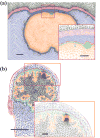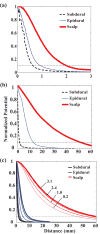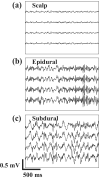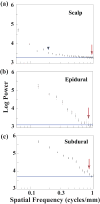Optimal spacing of surface electrode arrays for brain-machine interface applications
- PMID: 20197598
- PMCID: PMC2844916
- DOI: 10.1088/1741-2560/7/2/026004
Optimal spacing of surface electrode arrays for brain-machine interface applications
Abstract
Brain-machine interfaces (BMIs) use signals recorded directly from the brain to control an external device, such as a computer cursor or a prosthetic limb. These control signals have been recorded from different levels of the brain, from field potentials at the scalp or cortical surface to single neuron action potentials. At present, the more invasive recordings have better signal quality, but also lower stability over time. Recently, subdural field potentials have been proposed as a stable, good quality source of control signals, with the potential for higher spatial and temporal bandwidth than EEG. Here we used finite element modeling in rats and humans and spatial spectral analysis in rats to compare the spatial resolution of signals recorded epidurally (outside the dura), with those recorded from subdural and scalp locations. Resolution of epidural and subdural signals was very similar in rats and somewhat less so in human models. Both were substantially better than signals recorded at the scalp. Resolution of epidural and subdural signals in humans was much more similar when the cerebrospinal fluid layer thickness was reduced. This suggests that the less invasive epidural recordings may yield signals of similar quality to subdural recordings, and hence may be more attractive as a source of control signals for BMIs.
Figures








References
-
- Birbaumer N, Ghanayim N, Hinterberger T, Iversen I, Kotchoubey B, Kubler A, Perelmouter J, Taub E, Flor H. A spelling device for the paralysed. Nature. 1999;398:297–8. - PubMed
-
- Hochberg LR, Serruya MD, Friehs GM, Mukand JA, Saleh M, Caplan AH, Branner A, Chen D, Penn RD, Donoghue JP. Neuronal ensemble control of prosthetic devices by a human with tetraplegia. Nature. 2006;442:164–71. - PubMed
-
- Pohlmeyer EA, Perreault EJ, Slutzky MW, Kilgore KL, Kirsch RF, Taylor DM, Miller LE. Use of Intracortical Recordings to Control a Hand Neuroprosthesis. Neural Engineering, 2007 CNE '07 3rd International IEEE//EMBS Conference on; 2007. pp. 418–20.
Publication types
MeSH terms
Grants and funding
LinkOut - more resources
Full Text Sources
Other Literature Sources
